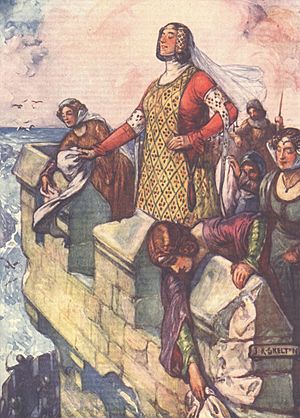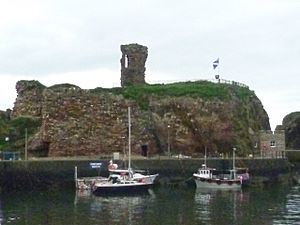Agnes, Countess of Dunbar facts for kids
Quick facts for kids
Agnes Randolph
|
|
|---|---|

Black Agnes, as depicted in a children's history book from 1906
|
|
| Born | c. 1312 Scotland |
| Died | 1369 (aged about 57) |
| Buried | Mordington, Berwickshire |
| Noble family | Randolph |
| Spouse(s) | Patrick, Earl of March |
| Father | Thomas Randolph, Earl of Moray |
| Mother | Isabel Stewart of Bonkyll |
Agnes Randolph, Countess of Dunbar and March (born around 1312 – died 1369), was a brave Scottish noblewoman. She was known as Black Agnes because of her dark hair and skin. Agnes was married to Patrick, the 9th Earl of Dunbar and March. She is buried in a special vault near Mordington House.
Agnes was the daughter of Thomas Randolph, Earl of Moray. Her father was a nephew and close friend of Robert the Bruce, a famous Scottish king. Agnes became very famous for her amazing defense of Dunbar Castle. This castle was in East Lothian, Scotland. She defended it against an English army led by William Montagu, 1st Earl of Salisbury. The siege started on January 13, 1338, and ended on June 10, 1338. This happened during the Second War of Scottish Independence, a time when Scotland fought for its freedom from England.
Defending Dunbar Castle
On January 13, 1338, while her husband Patrick was away, the English army surrounded Dunbar Castle. Agnes Randolph was inside with her servants and guards. She was determined not to give up the castle. She famously said that she would keep her home as long as it could keep her safe.
During the Middle Ages, it was common for wives to manage castles when their husbands were away. They would also defend them if needed. But Agnes's stand at Dunbar Castle is one of the most remembered stories.
The English commander, Salisbury, first tried to attack the castle. He used large machines called catapults to throw huge rocks and lead balls at the castle walls. Agnes showed she wasn't afraid. She had one of her ladies-in-waiting calmly dust off the castle walls with her kerchief. This showed how little she thought of the attack.
The English then brought a large wooden structure called a sow. This was a siege tower designed to help soldiers get close to the castle walls safely. Agnes warned Salisbury to "take good care of his sow." She said it would soon "cast its pigs" (meaning his men) inside the castle. Then, she ordered her men to roll a huge boulder down from the castle walls. This boulder crushed Salisbury's sow into pieces.
At one point, a Scottish archer shot an English soldier standing near Salisbury. The Earl joked, "There comes one of my lady's tire pins." He meant that Agnes's "love shafts" (arrows) went straight to the heart.
When fighting didn't work, Salisbury tried a trick. He bribed the Scottish guard at the main gate. He told the guard to leave the gate unlocked so the English could easily get in. But the guard, even though he took the money, told Agnes about the plan. So, Agnes was ready for the English. When Salisbury led his men forward, one of his soldiers pushed past him. Just then, Agnes's men quickly dropped the portcullis (a heavy gate). This trapped the English soldier inside, separating him from Salisbury. Agnes had wanted to trap Salisbury himself. She then shouted at him, "Farewell, Montague! I wanted you to have supper with us and help us defend the castle!"
At one point, the English captured Agnes's brother, John Randolph, 3rd Earl of Moray. They brought him to Dunbar. Montague threatened to hang him if Agnes did not surrender the castle. But Agnes bravely replied that his death would only help her. She said she was his heir. She meant she would inherit his lands, along with her sister.
After several months, supplies for her garrison (the soldiers defending the castle) started to run low. Sir Alexander Ramsay of Dalhousie, a Scottish hero, came to help. He traveled from Edinburgh to the coast with 40 men. They found some boats and approached the castle by sea. They entered through a small gate called a postern near the water. The Scotsmen then rushed out of the castle. They surprised Salisbury's advance guard (the soldiers at the front) and pushed them all the way back to their camp.
After five months, Salisbury finally gave up. He ended the siege on June 10, 1338. This victory by a Scottish woman over a large English army was celebrated in a song. The song said that Salisbury admitted, "Cam I early, cam I late, I found Agnes at the gate."
The failed siege of Dunbar cost the English king almost 6,000 English pounds. They gained nothing from it. For many years, Agnes Randolph's brave defense of Dunbar Castle was remembered by writers and historians. They praised her courage and strength.
Family Connections
Agnes Randolph's family was very important in Scotland's fight for independence. Her father, Thomas Randolph, Earl of Moray, was a regent (a temporary ruler) of Scotland from 1329 to 1332. Agnes's brother also became a regent in 1335, but he was captured by the English soon after.
In 1324, Agnes married Patrick, the ninth Earl of Dunbar and March. He was also the governor of Berwick. After a Scottish loss at the Battle of Halidon Hill, Patrick had to make peace with the English. He gave up Berwick, which he was in charge of. The English ordered him to make Dunbar Castle stronger. However, by the next year, he had returned to supporting Scotland. He fought against the English whenever he could.
Agnes and Patrick did not have any children who survived. Their lands were left to the children of Patrick's cousin, John de Dunbar, and Agnes's younger sister, Isobel Randolph.
Agnes's three nephews were:
- George, Earl of Dunbar and March
- John Dunbar, Earl of Moray
- Sir Patrick de Dunbar, of Beil
See Also
- List of women warriors in folklore


